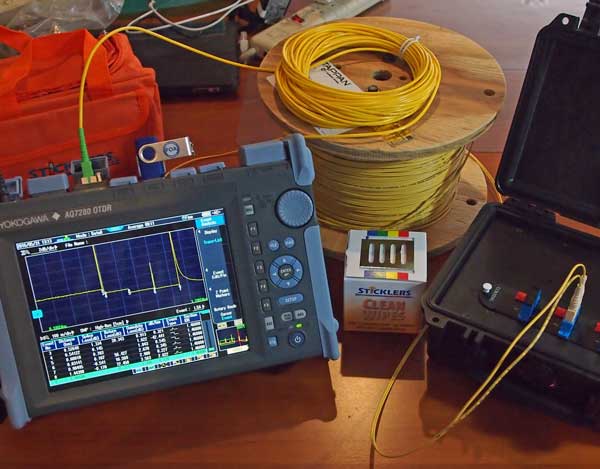Revealing the Trick Use Optical Fiber Evaluating for Reliable Data Transmission
In the world of modern interaction, optical fiber testing arises as an essential method for enhancing information transmission. Comprehending the multifaceted applications of optical fiber testing invites a much deeper exploration right into its essential function in forming the future of information interaction.
Relevance of Optical Fiber Screening
The relevance of optical fiber screening can not be overemphasized, as it acts as an essential component in ensuring the reliability and efficiency of information transmission systems. In a period where high-speed interaction is extremely important, any deficiencies in fibre optics can cause significant data loss and decreased efficiency. Therefore, strenuous screening protocols are necessary to validate the integrity and performance of optical cable televisions.
Evaluating enables for the recognition of defects such as micro-bends, macrobends, and splice losses that can hinder signal top quality. It offers insights right into the overall depletion and bandwidth capacities of the fiber, guaranteeing that the network satisfies specific functional standards. Normal testing not only enhances system performance but also extends the lifespan of the infrastructure by determining potential problems prior to they escalate right into pricey failings.

Kinds of Optical Fibre Tests
Different sorts of optical fiber tests are conducted to make certain the performance and integrity of fiber optic networks. These examinations can be categorized right into several essential kinds, each serving a details purpose in examining the stability of the fiber.
First, Optical Time Domain Reflectometry (OTDR) is a noticeable examination that recognizes mistakes, entwines, and ports within the fiber. By sending pulses of light and assessing the reflected signals, service technicians can pinpoint issues along the fiber's size.
2nd, insertion loss examinations review the amount of signal loss when light travel through connectors or splices, which is essential for keeping network effectiveness.
Third, return loss tests determine the quantity of light showed back towards the source, offering understandings into the top quality of connections and possible sources of interference.
In addition, continuity examinations make certain that the fiber path is full, enabling technicians to verify that the fiber is undamaged with no breaks. fibre testing equipment.
Finally, aesthetic mistake locators use visible light to recognize breaks or severe bends in the fiber, aiding in fast troubleshooting. Collectively, these examinations form a comprehensive approach to keeping ideal click site performance in fibre optic networks.

Applications in Network Maintenance
In contemporary telecoms, effective network upkeep depends heavily on optical fibre testing to identify and rectify concerns promptly. Normal testing makes sure that the network runs at optimum efficiency degrees, minimizing downtime and enhancing individual experience.
One of the main applications of optical fiber screening in maintenance is the detection of faults, such as breaks, flexes, or inappropriate connections. Methods like Optical Time Domain Reflectometry (OTDR) allow professionals to find these concerns precisely and evaluate the high quality of the fibre web link. Furthermore, loss screening confirms the honesty of the optical path, making certain that signal depletion stays within acceptable restrictions.
Regular upkeep screening likewise aids in safety nets, identifying potential problems prior to they intensify right into considerable failures. This positive approach can save organizations both time and financial resources. Furthermore, during upgrades or growths, optical fibre screening ensures that brand-new installments incorporate perfectly with existing facilities.
Enhancing Data Transmission Reliability
Efficient network upkeep with optical fiber screening not just addresses immediate problems however also plays a substantial role in boosting data transmission integrity. By identifying mistakes, gauging signal loss, and Recommended Reading assessing the overall problem of fibre optic cables, testing makes sure that possible problems are remedied prior to they rise right into substantial disruptions.
Regular optical fibre testing, such as time-domain reflectometry (TDR) and optical time-domain reflectometry (OTDR), allows professionals to determine the precise places of breaks, bends, or connector issues within the network. This positive technique not only minimizes downtime but also maximizes the efficiency of information transmission by guaranteeing that the pathways for signals are clear Clicking Here and working efficiently.
In addition, testing help in verifying adherence to sector criteria and specs, which is crucial for preserving the honesty of data flow. By guaranteeing that each connection satisfies required thresholds for loss and top quality, companies can strengthen their confidence in the integrity of their data networks.
Ultimately, investing in extensive optical fibre screening not just boosts data transmission dependability however additionally sustains the long-lasting functional efficiency of interaction frameworks.
Future Fads in Fibre Screening
Emerging innovations are poised to change fiber testing, leading the way for enhanced performance and accuracy in data transmission diagnostics (ofda). As the need for faster internet and greater bandwidth proceeds to rise, the assimilation of innovative devices such as expert system (AI) and device knowing (ML) is readied to transform traditional fiber screening techniques. These innovations will make it possible for predictive upkeep and automated mistake detection, dramatically decreasing downtime and improving network reliability
Additionally, the fostering of Internet of Points (IoT) gadgets will certainly facilitate real-time tracking of fibre networks, enabling prompt identification of efficiency concerns. This shift in the direction of aggressive management will certainly decrease disturbances and enhance data circulation.
Furthermore, innovations in optical time-domain reflectometry (OTDR) and brand-new screening standards will certainly boost the accuracy of measurements, guaranteeing that information honesty is preserved throughout the transmission procedure. The arrival of 5G technology likewise requires the advancement of a lot more innovative fibre testing techniques to sustain its high-speed requirements.
Verdict
Finally, optical fiber testing is important for preserving efficient information transmission within communication networks. By employing different testing techniques, such as OTDR and insertion loss examinations, prospective mistakes can be determined and fixed, thereby boosting signal clearness and minimizing downtime. Regular testing not just makes certain compliance with market standards but additionally promotes aggressive upkeep, eventually adding to the long-term dependability and efficiency of fibre optic systems. The continued advancement of screening methods will certainly even more reinforce these capabilities in the future.